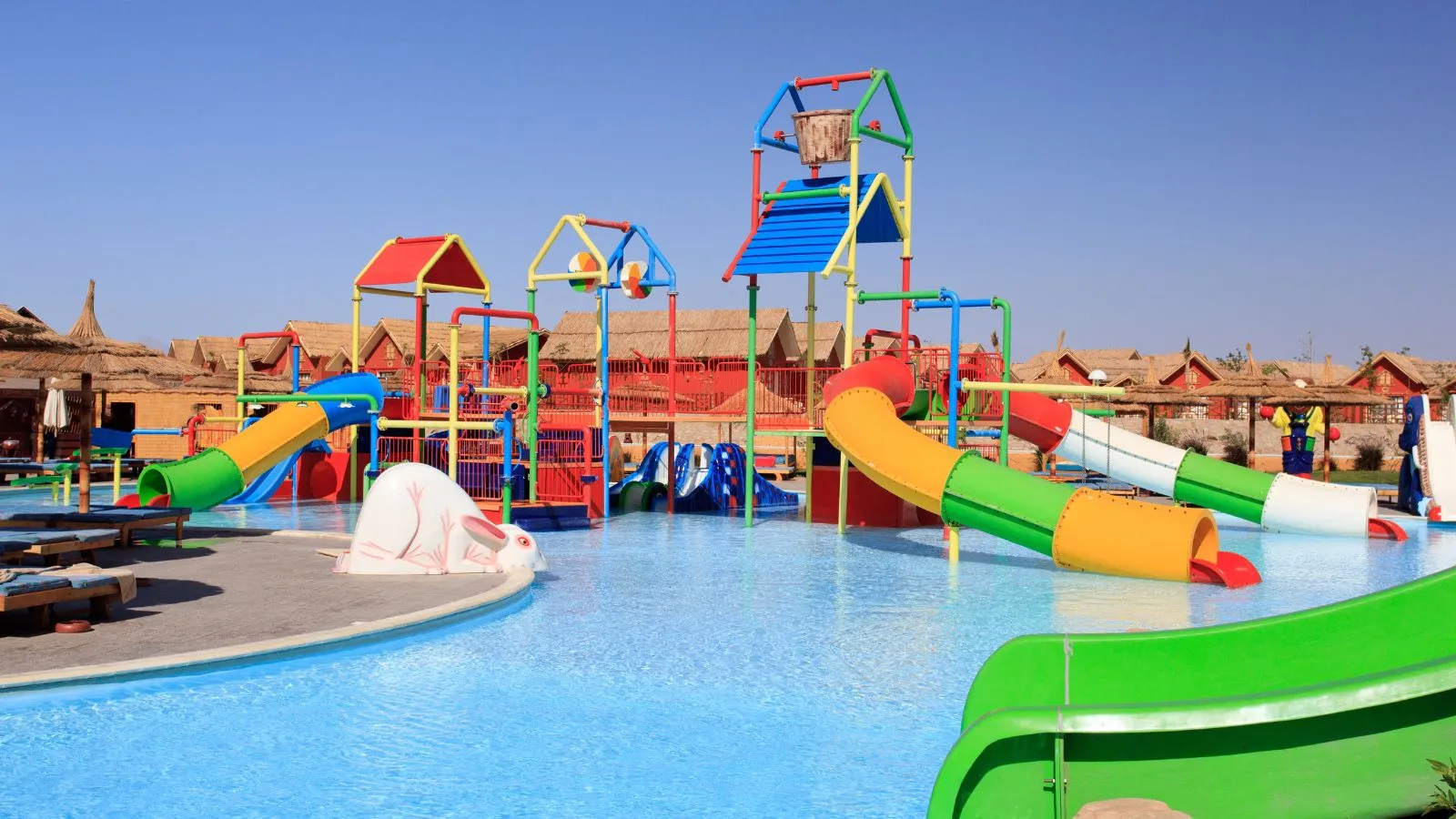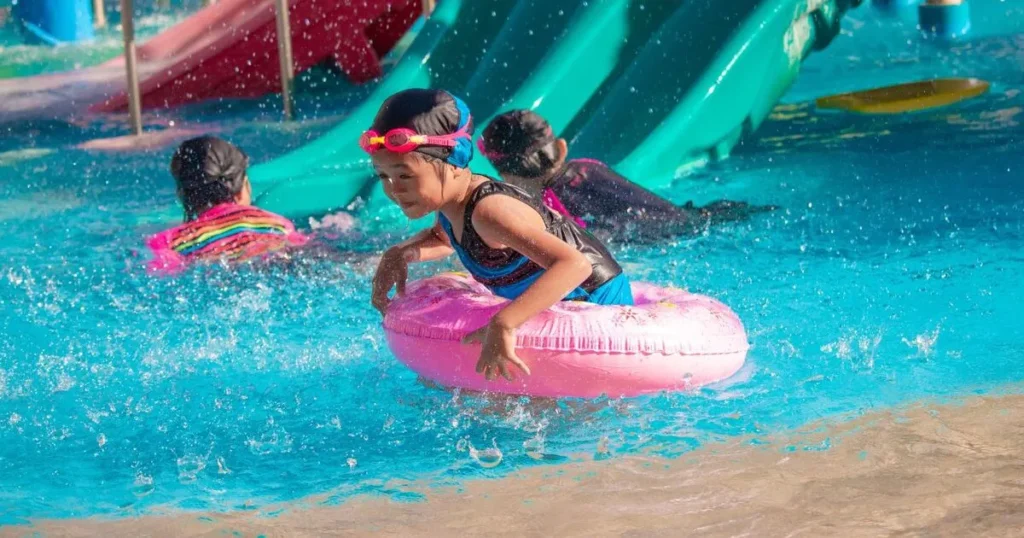Stay Safe and Have Fun: A Guide to Water Park Safety

The Importance of Water Park Safety
Water parks are fun, exciting, and a perfect way to cool off on hot summer days. However, they can also be dangerous if proper safety precautions are not taken. Every year, thousands of people are injured at water parks due to accidents that could have been prevented with a little bit of caution.
This is why water park safety should be taken seriously by everyone who visits these attractions. The importance of water park safety cannot be overstated.
Slides, wave pools, and lazy rivers might seem harmless at first glance, but there are many hidden dangers that can lead to serious injury or even death. From broken bones and concussions to drowning incidents or spinal cord injuries, the risks associated with water park attractions can’t be ignored.
According to the CDC (Centers for Disease Control and Prevention), thousands of people visit emergency rooms every year due to injuries sustained at water parks across the United States. The majority of these incidents involve children under the age of 12 who suffer from lacerations, fractures or head trauma while using slides or other attractions.
A Personal Anecdote
I remember going to a water park with my family when I was younger and being excited about trying out the tallest slide in the park. I had seen other kids go down it and it looked like so much fun! However, when it was finally my turn I got scared and decided not to go through with it.
That decision probably saved me from getting hurt because as I watched others take their turns on the slide I noticed that one girl got stuck halfway down due to a mechanical malfunction. She ended up suffering from some minor injuries but she could have easily been more severely hurt if she had fallen from such great heights.
This experience made me realize that no matter how fun and tempting water park attractions might be, it’s always important to prioritize safety over thrill-seeking. Taking a few simple precautions can save you from getting hurt and ensure that your day at the water park remains an enjoyable one.
General Water Park Safety Tips
Water parks can be a lot of fun, but they can also be dangerous if you don’t take the necessary safety precautions. Here are some general water park safety tips that everyone should follow to ensure a safe and enjoyable experience.
Wear appropriate swimwear and footwear
Swimwear should fit properly and not be too loose as it can get caught in the water slide or other attractions. For women, one-piece swimsuits are recommended as they provide more coverage and support.
Men should avoid wearing loose-fitting swim trunks that could come off while going down a slide or diving into a pool. Proper footwear is also important to prevent slipping on wet surfaces.
Follow the rules and regulations
All water parks have rules and regulations posted throughout the park, including at each attraction. It’s important to read and follow these rules to prevent accidents from happening. Rules may include height restrictions for certain attractions, weight limits for tubes or rafts, no diving signs, or warnings about dangerous activities.
Stay hydrated and take breaks as needed
Spending hours in the hot sun can lead to dehydration which can cause dizziness, nausea, headaches, and fatigue. Be sure to drink plenty of water throughout the day even if you don’t feel thirsty.
Take breaks in between attractions to rest in shaded areas or air-conditioned buildings. It’s important to remember that every water park has its own set of rules and guidelines for safety purposes so make sure you familiarize yourself with them before you start your day of fun!
Water Slide Safety
Proper Sliding Techniques (Crossed Arms, Feet First)
Water slides are one of the most thrilling attractions at any water park. However, they can also be dangerous if not used properly. One of the most important safety tips when it comes to water slides is to use proper sliding techniques.
This means crossing your arms over your chest and going down feet first. This helps keep your body stable and prevents you from hitting your head or other body parts on the sides of the slide.
It’s also important to keep both hands and feet inside the slide at all times. When going around curves or bends in the slide, it can be tempting to stick an arm or leg out for balance, but this is extremely dangerous and could result in serious injury.
Height Restrictions and Weight Limits
Another key aspect of water slide safety is understanding height restrictions and weight limits. These restrictions are put in place for a reason – to ensure that riders are safe while using the attraction. Always pay attention to posted signs regarding height requirements before getting in line for a water slide.
Similarly, weight limits are also important to follow. Overloading a water slide can cause it to malfunction or break, which could result in serious injuries for riders.
Avoiding Dangerous Behaviors (Standing, Diving)
While it may seem like common sense, many people still engage in dangerous behaviors while using water slides. Standing up on a water slide is incredibly dangerous as you could lose your balance and fall off mid-ride – potentially resulting in serious injuries.
Similarly, diving headfirst down a water slide is never a good idea as this puts you at risk of hitting your head on the bottom of the pool at the end of the ride. Always go down slides feet first while lying on your back with crossed arms.
Always follow proper sliding techniques such as crossing your arms and going feet first, paying attention to posted height requirements and weight limits, and avoiding any dangerous behaviors such as standing or diving headfirst down a water slide. By following these tips, you can ensure that you have a fun and safe experience on all of the water slides at the park.

Wave Pool Safety
The Importance of Swimming Ability
One of the most important aspects of wave pool safety is having strong swimming ability. Unlike other water park attractions, wave pools are designed to simulate the ocean and create waves that can be difficult to handle for those with limited experience in the water.
It’s recommended that all visitors to a wave pool have some level of proficiency in swimming before attempting to enter the pool. If you’re not a strong swimmer, it’s best to stay in the shallow areas or designated children’s sections where waves are less intense.
Additionally, consider wearing a life vest or floatation device if you’re unsure about your swimming abilities. It’s better to be safe than sorry when it comes to enjoying amusement park attractions.
Staying Within Designated Areas
Another important aspect of wave pool safety is staying within designated areas. Most wave pools have clear markers or ropes indicating where the deep end begins and ends and where swimmers should stay within while enjoying the attraction. Staying within these designated areas can significantly reduce your risk of injury.
For example, if you’re not comfortable swimming in deep water, avoid venturing too far into the middle of the pool where waves may be stronger and more difficult to manage. Similarly, avoid jumping off rocks or diving from inappropriate locations as this may put you at risk for serious injury.
Watching for Sudden Changes in Wave Patterns
When enjoying a wave pool attraction, it’s essential always to be aware of sudden changes in wave patterns that can occur without warning.
While most parks employ experienced lifeguards who will monitor conditions and make announcements over loudspeakers if necessary, it’s ultimately your responsibility as a visitor always to be alert. If you notice sudden changes in water depth or increased turbulence around you, move towards shallower waters immediately or exit the pool.
Similarly, if you notice other swimmers struggling to stay afloat or in distress, alert a lifeguard immediately. By following these tips and remaining vigilant while enjoying wave pool attractions at water parks, you can help ensure that your experience is both enjoyable and safe.
Lazy River Safety
Proper Use of Tubes or Rafts
One of the most relaxing attractions at any water park is the lazy river. However, that doesn’t mean you can let your guard down when it comes to safety. The first thing you need to know is how to use the tubes or rafts provided by the park.
Always make sure that they are properly inflated and don’t have any holes or tears before getting in. When getting on a tube, sit down first and then carefully lower yourself onto your back.
Hold onto the handles on either side of the tube and keep your feet up in front of you to avoid scraping them on the bottom of the river. If your feet do touch, just stand up and readjust yourself. Stay within arm’s reach of other tubers around you.
Avoiding Overcrowding and Collisions with Others
Another important aspect of lazy river safety is avoiding overcrowding and collisions with other riders. Follow all posted signs regarding maximum occupancy for each tube or raft, and don’t try to squeeze more people onto one than recommended.
Also, be aware of other riders around you. Keep a safe distance from others and don’t try to pass them too closely or too quickly.
If someone falls off their tube or needs help, stop immediately and try to assist them without causing harm to yourself or others. Remember that lazy rivers can get quite crowded during peak hours, so if you prefer a more peaceful ride, try going early in the morning or later in the evening when there are fewer people around.
The Bottom Line:
Enjoy all that lazy rivers have to offer, but stay safe by properly using your tube or raft and avoiding collisions with others.
Children’s Area Safety
As much as water parks are a fun place to be, they can also pose serious dangers to children. The water park management understands this and has put up safety measures to ensure that children stay safe while enjoying the various attractions. However, it is important for parents and guardians to take an active role in ensuring their safety.
Adult Supervision at All Times
One of the most important measures of ensuring children’s safety in a water park is adult supervision. Parents or guardians should always ensure that their children are within their sight.
Even if the child is old enough to go on rides alone, they should still be supervised from afar by an adult. It is also advisable that parents accompany their children on rides deemed unsafe for kids below a certain age or height limit.
This way, they can provide guidance and assistance where necessary. Additionally, it provides peace of mind knowing that your child is safe under your watchful eye.
Height Restrictions and Age Limits for Certain Attractions
The water park has set specific height restrictions and age limits for some of its attractions. These restrictions are put in place to ensure that only those who meet the requirements are allowed on the rides.
Parents should familiarize themselves with these restrictions before letting their kids go on any ride. It is important to note that these restrictions aren’t put in place just for fun; they are there for safety reasons.
Going on rides meant for older or taller individuals could lead to injuries due to a lack of physical readiness or fear. Parents should also look out for signs indicating any health conditions when letting their child go on a ride; some rides may not be suitable for individuals with certain medical conditions.
The Importance of Child Safety in Water Parks
Water parks can be great places to make memories with your family, but it’s crucial not to disregard being safe. As a parent, you should ensure that your child is always supervised and informed about all the safety rules in place. By following all the rules and taking a proactive approach toward safety, you and your family can enjoy an enjoyable day at the water park without any mishaps.
Lifeguard Responsibilities
Lifeguards are the unsung heroes of any water park. While visitors are busy enjoying the attractions, these trained professionals are constantly scanning the water, ready to jump into action in case of an emergency.
Their main responsibility is to ensure the safety of all guests. At most water parks, lifeguards will be stationed at every attraction where there is water.
These lifeguards have undergone extensive training in first aid and CPR, and they must pass rigorous tests before being able to work at a water park. They are responsible for enforcing all rules and regulations posted around each attraction and monitoring guests to ensure their compliance.
In addition to watching for potential hazards or rule breakers, lifeguards also keep track of weather patterns that could affect guest safety. If lightning is detected in the area or if winds pick up suddenly, they may need to evacuate certain attractions or even close down the entire park until conditions improve.
Their role in ensuring safety at the water park
Lifeguards have a major role in making sure that visitors have a safe and enjoyable experience while at the water park. They are responsible for preventing accidents before they occur by being proactive in their surveillance techniques.
This includes constantly scanning areas of responsibility with binoculars or from high vantage points like towers. If a guest does become injured or suffers from heat exhaustion, it is also up to lifeguards to respond quickly with appropriate care.
In many cases, this means jumping into action by administering CPR/first aid treatment if necessary once securing proper training prior.
It’s important for visitors to understand that while lifeguards work hard to maintain safety standards throughout their shifts, they cannot guarantee complete protection from accidents or mishaps; it’s still important for individuals & parents to supervise themselves & children by following attraction rules as well as staying aware of surrounding hazards like slippery surfaces & deep ends of pools.
How to locate a lifeguard in case of emergency
In the event of an emergency, it’s crucial for guests to know how to locate a lifeguard. Before entering the park, take note of where each lifeguard station is located.
If you’re not sure where the closest one is, ask a park employee for directions. If you need immediate assistance and are unable to reach a lifeguard station, look for help from another guest or seek out an employee.
All park employees should be trained in emergency response procedures and will be able to assist you until a lifeguard arrives. It’s also important for visitors to be aware that they can play an active role in ensuring their own safety by following all posted rules and regulations around each attraction.
This includes paying attention to height requirements, weight restrictions, and any other warnings or restrictions listed around the attraction. By working together with water park staff and taking personal responsibility for our own safety while at the park, we can help ensure that everyone has a fun-filled and safe time.
First Aid Procedures
Water parks are designed to provide hours of entertainment and fun, but accidents can still happen. In case of minor injuries such as cuts or scrapes, it’s important to have basic first aid knowledge.
First and foremost, make sure the injured person is removed from the water to prevent further injury or infection. If there is bleeding, apply pressure with a clean cloth or towel until it stops.
Rinse the wound with clean water and apply an adhesive bandage or gauze pad. If the wound is deep or doesn’t stop bleeding after several minutes of pressure application, seek medical attention.
In case of sunburns, blisters, or mild burns caused by hot surfaces such as pool decks or water slide stairs, apply a cool compress for 10-15 minutes several times per day and keep the affected area covered with loose clothing. For insect bites and stings, remove any stingers if present (using tweezers), wash the area with soap and water then apply ice packs to reduce swelling.
Emergency Procedures for Drowning
Drowning in a water park can be a scary experience for both victims and bystanders but knowing what steps to take beforehand can save lives. If you see someone drowning or in distress in the water, immediately alert lifeguards who are trained in rescue techniques such as throw rescues (using life-saving rings) or reach rescues (using poles).
If there isn’t any lifeguard around yet you know basic swimming techniques, try reaching out to them using a long object such as a pole while remaining on stable ground yourself. If you’re at the poolside when someone is pulled from the water exhibiting signs of drowning take action right away.
Check if they are unresponsive but breathing normally (in which case place them on their side), breathing slowly (in which case begin rescue breathing), or not breathing at all (in which case begin rescue breathing and call for emergency medical help). If you don’t know how to perform rescue breathing, ask someone nearby or follow the instructions available at the water park.
Emergency Procedures for Head Injuries
Head injuries caused by falls or collisions with hard surfaces are common in water parks. In case of a head injury, it is important to seek medical attention immediately. Signs of a serious head injury include loss of consciousness, dizziness, confusion, vomiting, and headache that worsens over time.
If you suspect someone has suffered a head injury in the water park or one of its rides or attractions, call 911 right away. If the injured person is conscious and responsive but complaining about headaches, apply an ice pack to the affected area for up to 20 minutes at a time several times per day.
Administer over-the-counter painkillers such as acetaminophen or ibuprofen only if authorized by a doctor since these medications can sometimes mask symptoms of more serious injuries. Encourage the person to rest quietly in an upright position while monitoring their symptoms until they can be seen by a medical professional.
Final Thoughts
After reading through all of the important safety tips for water parks, it may seem overwhelming, but remember that they are in place to ensure your safety and prevent accidents. Always follow posted rules and regulations, and never hesitate to ask a lifeguard or park employee for assistance or clarification.
To recap: wear appropriate swimwear and footwear, stay hydrated, and take breaks as needed. When enjoying water slides, follow proper sliding techniques and avoid dangerous behaviors like standing or diving.
In wave pools, make sure you are aware of your swimming ability and always stay within designated areas. Lazy rivers can be relaxing but make sure to use tubes or rafts properly and avoid overcrowding.
Children’s areas require constant adult supervision at all times. Remember that lifeguards are there to ensure your safety while enjoying the water park attractions.
They play a crucial role in preventing accidents by monitoring the area closely. In case of an emergency, know basic first aid tips for minor injuries like cuts or scrapes.
For more serious incidents like drowning or head injuries, seek emergency medical attention immediately. While safety is an essential aspect when visiting a water park, it’s also important to have fun!
The exhilarating rides and attractions offer experiences you won’t find anywhere else – just make sure you’re doing it safely. So go ahead – grab your sunscreen and swimsuit – now you’re ready for a day full of fun in the sun at the water park!






